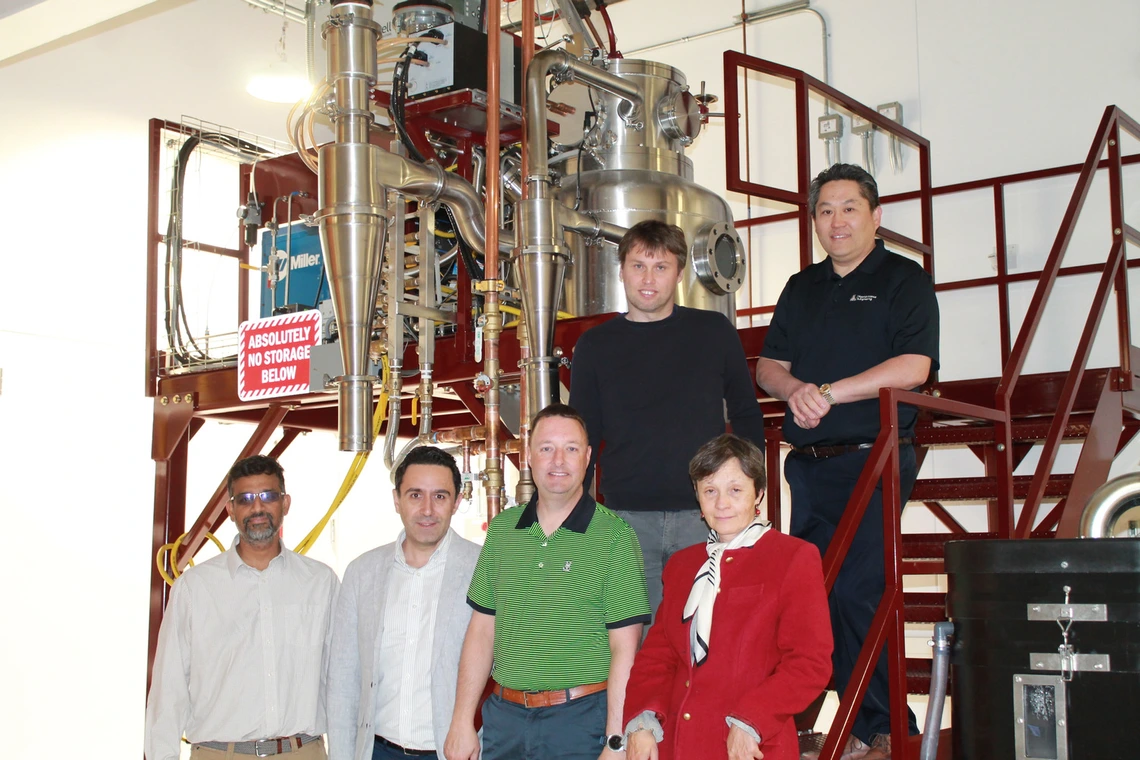College of Engineering team wins $5M to speed defense manufacturing

The Mach-X research team. Front row, from left: Krishna Muralidharan, Kavan Hazeli, Andrew Wessman and Oana Cazacu. Back row, from left, Benoit Revil-Baudard and Sammy Tin. The team uses emerging technologies like machine learning to boost the production of ultrafast aircraft.
The University of Arizona's Mach-X engineering team has been awarded a $5 million U.S. Army grant to design an alloy manufacturing process using 3D printing techniques and machine learning to make critical parts for vehicles that fly at least five times the speed of sound.
The National Center for Defense Manufacturing and Machining tasked the research team to create an efficient method that produces high-tolerance aircraft parts while reducing costs.
"This grant reflects how the University of Arizona’s well-regarded expertise in hypersonics and materials sciences can bolster the nation's defense capabilities," said University of Arizona Senior Vice President for Research and Partnerships Tomás Díaz de la Rubia. "Developing and fostering research partnerships of this kind helps the U of A shape the future and address pressing challenges, and we are excited to see what the Mach-X team designs."
Sammy Tin, the Patrick R. Taylor Endowed Department Leadership Chair of Materials Science and Engineering, leads the Mach-X team and is the grant's principal investigator.
"We are pioneering metal 3D printing techniques, as well as new and innovative alloys that can support the next generation of affordable hypersonic platforms," Tin said.
This is the second U.S. Army grant awarded to the Mach-X team in 2025; it received $3.1 million in March to develop refractory alloys.
"These very significant awards are further evidence that the University of Arizona is a leader in hypersonics research," said David W. Hahn, the Craig M. Berge Dean of the College of Engineering. "The funding brings together academia, government and industry to expand research capacities while supporting national priorities in homeland security and technology."
The Mach-X team – which includes materials science and engineering faculty members Krishna Muralidharan, Oana Cazacu, Andrew Wessman and Benoit Revil-Baudard, plus Ron Liang, the Thomas R. Brown Endowed Chair in the Wyant College of Optical Sciences, Tribikram Kundu from the Department of Civil, Architectural Engineering and Mechanics and Kavan Hazeli from the Department of Aerospace and Mechanical Engineering – will partner with Raytheon, an RTX business, to produce prototypes with nickel alloys that can tolerate the intense heat of hypersonic flight.
"A leading-edge structure or rocket nozzle structure needs to survive at temperatures above 1,100 degrees Celsius for extended periods and under high stresses," Tin said.
Employing 3D printing, AI in prototyping
Tin said the team's challenge will be to find the right mix of metals and a strong 3D printed microstructure that can handle hypersonic flight. To achieve this, they will employ machine learning and sophisticated nonlinear acoustic detection – a nondestructive process that uses sound waves to test the integrity of 3D printed parts – to refine the manufacturing process.
"We can assess the quality of the part as we're building it and make on-the-spot decisions if we need to go back and update the process," said Muralidharan.
According to Muralidharan, the acoustic testing is possible due to the research of Tribikram Kundu, a leader in this field.
Additionally, machine learning will be used to create computer simulations of print formations.
"We will train the algorithm on the simpler parts and use it to interpret the acoustic responses from the testing process," Muralidharan said. "That will tell us with a high degree of confidence if there are defects and which structures are working."
The project not only employs novel technology in defense manufacturing but also accelerates the university's discovery-to-deployment cycle of advanced materials.
"We can develop the powder, customize the alloy compositions, print in 3D, evaluate the products non-destructively, and ultimately do very high temperature mechanical testing here," Tin said.
"We will have unique, end-to-end capabilities on campus that very few universities or industrial companies have."





